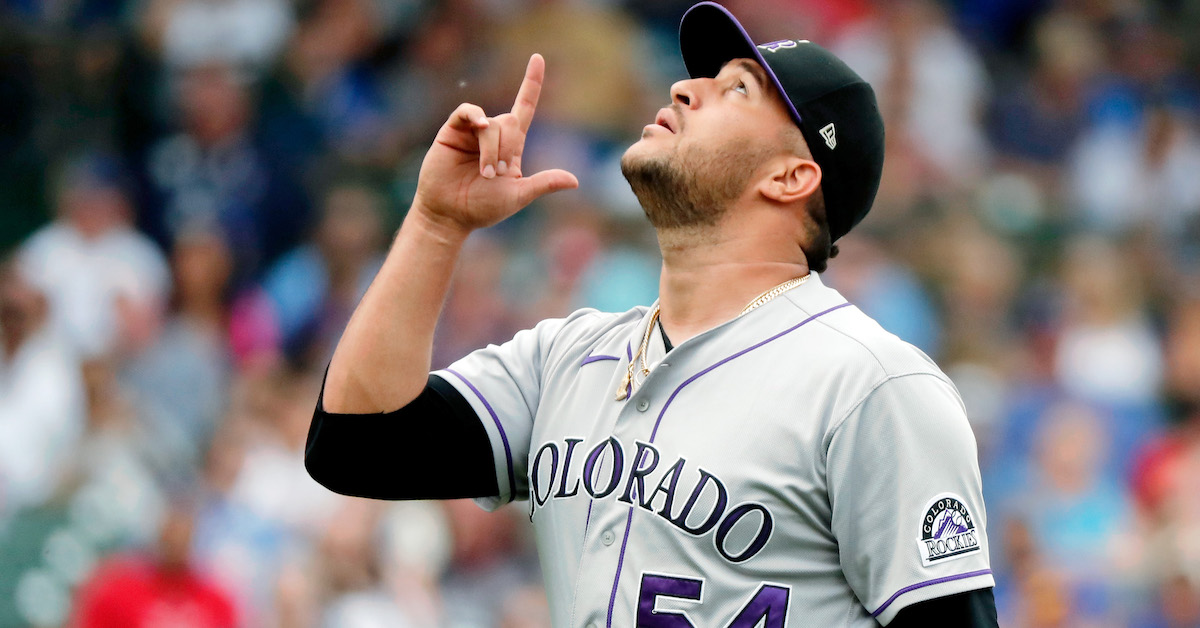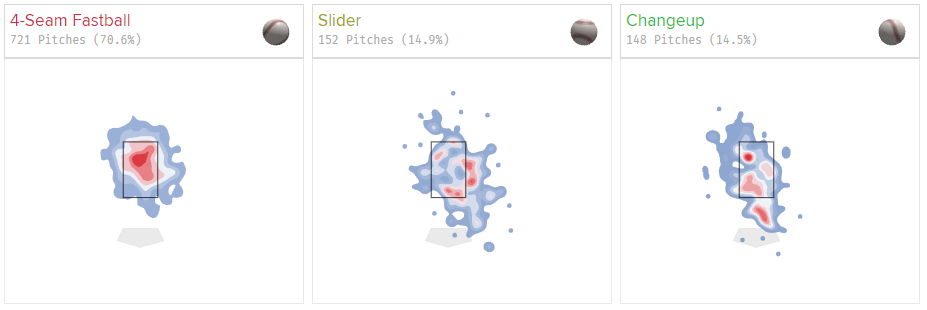In Signing Carlos Estévez, Angels Place Faith in a Change of Scenery

Free-agent reliever Carlos Estévez has signed a two-year contract worth $13.5 million with the Angels, continuing a busy offseason in Anaheim that has already seen Tyler Anderson, Gio Urshela, and Hunter Renfroe join the roster.
#Angels sign Carlos Estevez to a 2-year deal for $13.5-million.
Don’t know yet if they plan for him to close, but Bud Black just said he has closer stuff and a closer mentality.
— Jeff Fletcher (@JeffFletcherOCR) December 5, 2022
Estévez, who turns 30 next month, has spent his entire professional career with the Rockies, playing his first six seasons in the hitter’s paradise of Coors Field. His 4.59 ERA and 4.21 FIP in 302 career innings appear a bit inflated, but they’re actually a touch better than league average (94 ERA- and FIP-). His 2022 campaign, while normal-looking on the surface, was statistically odd in many ways. Despite earning fewer strikes than ever, he set a career best in terms of overall run prevention with a 3.47 ERA, making him the second-most effective reliever on Colorado’s staff.
| ERA- | BABIP | HR/FB | SwStr% | CStr% | |
|---|---|---|---|---|---|
| Carlos Estévez | 75 | .247 | 10.1% | 9.0% | 12.2% |
| League Average | 100 | .289 | 11.4% | 11.2% | 16.4% |
Wait — a .247 BABIP allowed while pitching in Coors, a stadium whose .323 BABIP ranked highest among all parks? And an above-average 10.1% HR/FB rate in the sixth-most homer-friendly park in baseball? And that was despite it being easier to make contact against Estévez than at any other point during his career?
Let’s dig a little bit deeper into those plate discipline numbers. His called and swinging-strike rates combine for a 21.2% CSW. That’s not just the worst of Estévez’ career (by a lot); it was, by a wide margin, the worst CSW of any reliever with at least 50 innings in 2022. In this era of baseball, we know that not missing bats and playing roulette with balls in play is generally a recipe for disaster, especially in a pinball machine of a stadium. To illustrate this, let’s look at Estévez’ closest competitors for the worst CSW of 2022, along with their FIP- marks:
| Name | CSW% | FIP- |
|---|---|---|
| Carlos Estévez | 21.3% | 97 |
| Ian Kennedy | 23.6% | 142 |
| Bryan Shaw | 24.5% | 124 |
| Andre Pallante | 24.6% | 102 |
| Joel Payamps | 24.7% | 110 |
| Jason Foley | 24.8% | 71 |
| John King | 25.0% | 103 |
| Mark Melancon | 25.1% | 108 |
| Nick Nelson | 25.2% | 76 |
| Hirokazu Sawamura | 25.4% | 106 |
Those are some of the worst relievers in the league from the season prior, including Kennedy, whose 142 FIP- ranked last in baseball. Yet despite whiff numbers that look more like they’re from 1982 than 2022, Estévez was above average even when looking at peripheral numbers. His solid production is joined on this list by the likes of Foley and Nelson, whose very good fly ball luck gave them unsustainably low HR/9 figures.
Let’s take a look at one more chart. I’ve mentioned Estévez’ former home ballpark a couple of times in explaining the peculiarity of his strong 2022 results, but exactly how well did he do in and away from Denver over the past season?
| ERA | FIP | wOBA | BABIP | K% | BB% | K-BB% | |
|---|---|---|---|---|---|---|---|
| Home | 3.45 | 4.51 | .284 | .215 | 16.8% | 11.8% | 5.0% |
| Away | 3.49 | 3.64 | .297 | .282 | 29.3% | 5.1% | 24.2% |
Even in just a half-season sample, running a .215 BABIP in Coors Field is remarkable, especially given that Outs Above Average graded the Rockies’ outfield as the third worst in the league. But the most important takeaway from these splits isn’t the luck metrics; it’s the skill metrics. When looking at just walks and strikeouts, Estévez is a completely different pitcher in an environment where the air behaves normally. The thin air of Coors Field significantly reduces the spin-based movement of pitches, like the four-seam fastball that he throws over two-thirds of the time. In fact, among qualified pitchers, no one in 2022 threw heaters at a higher rate than him. Unsurprisingly, environmental factors had a huge impact on the physical properties, and thereby overall effectiveness, of Estévez’ fastball.
The most underrated free agent on the market in 2022?
I’ll take my chances with Carlos Estevez
— Matthew Kress (@m_kress__) November 30, 2022
The air in Denver sapped two inches of vertical carry and three inches of horizontal break from Estévez’ fastball, which by Driveline’s model is the difference between below average and elite. In addition to above-average vertical and horizontal movement, his four-seamer also has plus velocity (97.5 mph in 2022) and a relatively flat -4.6 degree vertical approach angle, as he produces a 5.7-foot release height despite measuring in at 6-foot-6. By Cameron Grove’s pitch grader, his home fastball was a 51 on the 20–80 scale (about average), whereas his away fastball was a 59 (near plus) with a 25% expected whiff rate; his actual fastball whiff rate in 2022 was 21%. The drastic difference in stuff between these two fastballs can be seen in his disparate K-BB% at home and on the road. His 24.2% rate away from Denver tied him with Kenley Jansen; his 5% clip at home would have ranked him 143rd of 144 relievers.
These fastball traits combined with their high usage rate gives Estévez a good foundation for his arsenal, but let’s take a brief look at his secondaries. His main secondary weapon against right-handed hitters is a slider, which has been a slightly below-average offering throughout his career (-2.7 pitch value). While it had great results on contact in 2022 (.193 wOBA, .139 xwOBA), it suffered far worse results in previous seasons. The pitch lacks the horizontal movement that characterizes a sweeper, but its 10-mph difference from his fastball makes it less effective than tighter gyro sliders. Still, it has worked as an infrequent secondary offering to same-handed hitters sitting on a high fastball. Estévez also throws a changeup, mainly as a check against lefties, which has also been about average by our pitch value metric.
While he has consistently located his fastball at the letters throughout his career, Estévez’ command of both secondaries has been poor. Most pitchers’ heatmaps seem to show a general plan that they’re trying to execute, but his slider and changeup have been all over the place, especially during last season:

The Angels are no stranger to fastball-heavy relief profiles. José Quijada has found success with a similar fastball archetype, firing up in the zone from a low release point. Last season, he had a 3.85 FIP and 2.87 xERA throwing even more fastballs than Estévez. He joins an Angels bullpen that ranked 18th in relief ERA last season despite multi-year deals being given to free agents Ryan Tepera (104 FIP-) and Aaron Loup (92 FIP-) last offseason. There should be save opportunities, too; the Halos traded away relief ace Raisel Iglesias at last year’s deadline, and Estevez’ former manager in Colorado hinted that he may be in the mix to serve as the closer in Anaheim. Despite an impending sale, the Angels have shown a clear will to bolster their roster from top to bottom, and they may have signed one of the more underrated relievers available to do so.
Kyle is a FanGraphs contributor who likes to write about unique players who aren't superstars. He likes multipositional catchers, dislikes fastballs, and wants to see the return of the 100-inning reliever. He's currently a college student studying math education, and wants to apply that experience to his writing by making sabermetrics more accessible to learn about. Previously, he's written for PitcherList using pitch data to bring analytical insight to pitcher GIFs and on his personal blog about the Angels.

Every single reliever gets this deal from the Angels–2 or 3 years at roughly this AAV. It’s like they come up with the contract first, and then go to whoever they think the best reliever is who will take it. Do you think Perry Minasian has a lack of imagination, or that he’s dealing with ludicrous guidelines set by Arte Moreno?
Except Iglesias whom they quickly gave away. It’s as though they suddenly realized that corporate policy had been violated and they had to immediately correct the error
It can join “if the GM ever makes a second round draft pick, he must be terminated” in the big book of weird Angels operational laws.
I don’t know if that was actually the moment they lost any chance to sign Ohtani to an extension, but if there was still a chance then that trade killed it. Way to throw in the towel on the next few years, Angels.
Well freeing up that money has helped with acquiring Renfroe, Urshela, Anderson, now Estevez, hopefully with more to come… so I think this is an inaccurate assessment.